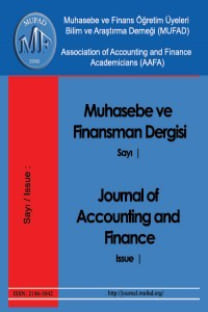UFRS Uyarınca Hiperenflasyonist Ekonomilerde Finansal Raporlama
Mayıs 2023 itibarıyla Türkiye’de resmî makamlarca açıklanan üç yıllık kümülatif enflasyon oranı %182 düzeyine yükselmiştir. Ancak reel hayatta gerçekleşen fiyat artışlarının resmî makamlarca açıklanan enflasyon oranından daha yüksek düzeyde olduğu yaşanan bir gerçektir. Hükümetin uygulamaya koyduğu irrasyonel ekonomik model neticesinde, Türk Lirası (TL)’nın değerinde hızlı bir düşüş yaşanmış ve Şubat 2022 itibarıyla Türkiye’de son üç yıllık kümülatif enflasyon uzun yıllar sonrasında %100’ü aşarak %100,63 düzeyinde gerçekleşmiştir. Uluslararası Muhasebe Standartları Kurulu tarafından 1989 yılında (O tarihlerde kurulun unvanı Uluslararası Muhasebe Standartları Komitesidir) yayınlanmış olan 29 no’lu Hiperenflasyonist Ekonomilerde Finansal Raporlama Standardı (IAS 29 Financial Reporting in Hyperinflationary Economies), fonksiyonel para birimi hiperenflasyonist bir ekonominin para birimi olan işletmelerin finansal tablolarının hangi kurallar dahilinde raporlanacağı hususunda rehberlik etmektedir. Bu çalışmanın amacı, fonksiyonel para birimi TL olan işletmelerin finansal tablolarının 29 no’lu Hiperenflasyonist Ekonomilerde Finansal Raporlama Standardına uygun olarak raporlanması sürecine katkıda bulunmaktır.
Anahtar Kelimeler:
UFRS, Finansal Raporlama, Hiperenflasyon
Financial Reporting In Hyperinflationary Economies Under IFRS
As of May 2023, the three-year cumulative inflation rate announced by official authorities in Turkey increased to 182%. However, it is a reality that the price increases in daily life are higher than the inflation rates announced by the official authorities. As a result of the irrational economic model put into practice by the government, the value of the Turkish Lira decreased rapidly and as of February 2022, the cumulative inflation in Turkey for the last three years exceeded 100% after many years and increased to 100.63%. IAS 29 Financial Reporting in Hyperinflationary Economies, which was published by International Accounting Standards Board in 1989 (Title of the Board was International Accounting Standards Committee at that time), provides guidance on the rules to report the financial statements of companies whose functional currency is the currency of a hyperinflationary economy. This study has been prepared for the reporting process of the financial statements of companies whose functional currency is Turkish Lira in accordance with Financial Reporting in Hyperinflationary Economies. The aim of this study is to contribute for the reporting process of the financial statements of companies whose functional currency is Turkish Lira in accordance with IAS 29 Financial Reporting in Hyperinflationary Economies.
Keywords:
IFRS, Financial Reporting, Hyperinflation,
___
- Akçin, O. (2022), Muhasebe ve Finansal Raporlamada Güncel Trendler. Muhasebe ve Denetimde Yeni Gelişmeler, Güncel Trendler, Editör: T. Ala, (s. 59-86). Ankara: Gazi Kitabevi.
- IASB (2023), Conceptual Framework for Financial Raporting, http://eifrs.ifrs.org (3 Haziran 2023).
- IASB (2023), IAS 21 The Effects of Changes in Foreign Exchange Rates, http://eifrs.ifrs.org(3 Haziran 2023).
- IASB. (2023), IAS 23 Borrowing Costs. http://eifrs.ifrs.org, (3 Haziran 2023).
- IASB. (2023), IAS 29 Financial Reporting in Hyperinflationary Economies, http://eifrs.ifrs.org ( 3 Haziran 2023).
- IASB. (2023), IFRS 10 Consolidated Financial Statements, http://eifrs.ifrs.org (3 Haziran 2023).
- IASB (2023), IFRIC 7 Applying the Restatement Approach under IAS 29 Financial Reporting in Hyperinflationary Economies, http://eifrs.ifrs.org (3 Haziran 2023).
- Orhan, O. Z. (1995), Başlıca Enflasyon Teorileri ve İstikrar Politikaları. İstanbul: Filiz Kitabevi,
- Sevilengül, O. (2011), Genel Muhasebe, Gazi Kitabevi, Ankara.
- TÜİK. (2023), Türkiye İstatistik Kurumu. www.tuik.gov.tr (3 Haziran 2023).
- Yükçü, S. - Özkan, S. (2004), SPK Tebliğleri ve 5024 Sayılı Kanuna Göre Enflasyon Muhasebesi, Yaklaşım Yayıncılık, Ankara.
- ISSN: 2146-3042
- Yayın Aralığı: Yılda 4 Sayı
- Başlangıç: 2005
- Yayıncı: Muhasebe ve Finansman Öğretim Üyeleri Derneği (MUFAD)
Sayıdaki Diğer Makaleler
UFRS Uyarınca Hiperenflasyonist Ekonomilerde Finansal Raporlama
Muhasebe İhtiyatlılığı ve Sürdürülebilirlik: BIST 100’de Bir Araştırma
Nebi SEREN, Murat Hakan ALTINTAŞ
Yusuf TEPELİ, Yunus Emre KAHRAMAN
Bitcoin’in kriz dönemindeki çeşitlendirici etkisi: G7’den kanıtlar
Finansal Gelişimin Vergi Gelirlerine Etkisi: Fourier Yaklaşımlar ile Türkiye’den Kanıtlar
